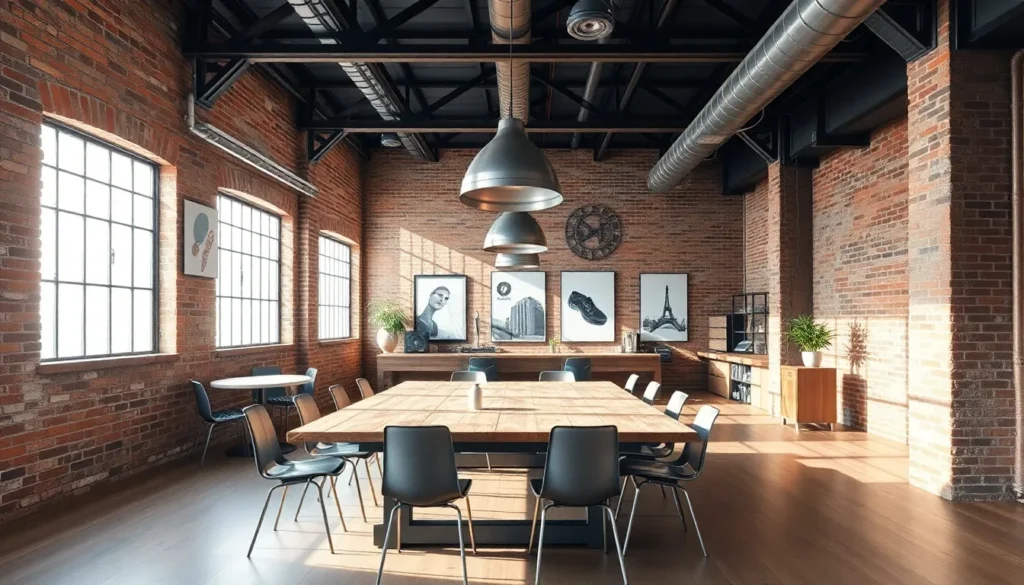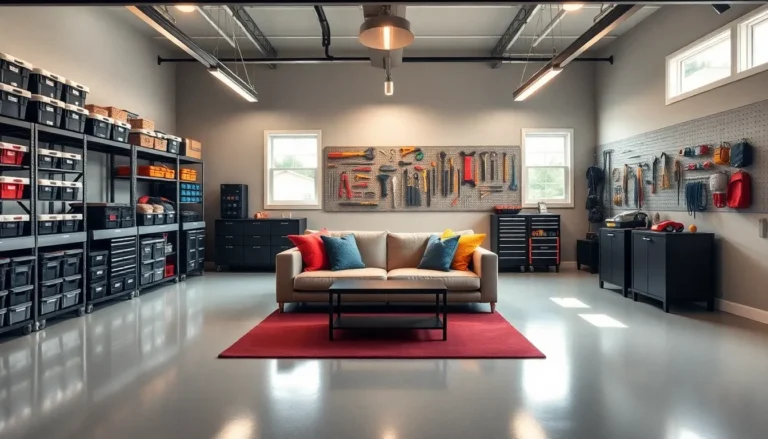Table of Contents
ToggleImagine walking into a room that whispers stories of bygone factories and urban lofts, where raw materials meet creativity. Industrial interior design is all the rage these days, and for good reason. It combines function and form with gritty aesthetics, making any space feel like it’s straight out of a trendy design magazine. Whether it’s your home, office, or boutique, embracing this style can add an edge to your environment. Buckle up as we explore how to make industrial designs work for you, without breaking a sweat, or the bank.
Understanding Industrial Design Aesthetics

Industrial design aesthetics draw inspiration from factories and warehouses, often characterized by their utilitarian feel. Think exposed brick, steel beams, and large factory windows that allow ample natural light. This style emphasizes a minimalist approach while leaving behind marks of wear and tear, celebrating imperfections in materials and structure.
Rooted in the early 20th century, industrial spaces reminisce about industrialization, where functionality was priority number one. Homes and workplaces have embraced this aesthetic, leading to a surge in popularity worldwide. When one steps into an industrial-themed space, they might feel as though they’ve ventured into a chic workshop, never dull, often vibrant, and always engaging.
The beauty of industrial design lies in its adaptability. It can be tailored to various tastes, allowing for an eclectic mix of vintage and modern elements, surprising elements often emerge, creating delightful visual stories.
Key Elements of Industrial Interior Design
Several key elements define industrial interior design, contributing to its unique appeal. Here are some important features to consider:
- Raw Materials: Materials like metal, wood, and brick play pivotal roles, contributing to a gritty and authentic look. Large wooden tables paired with metal chairs create striking contrasts.
- Exposed Structures: Beams and ductwork shouldn’t be hidden away. Instead, they become focal points that highlight the industrial ethos. Open layouts allow for free movement, creating spacious environments.
- Neutral Colors: Gray tones, browns, and blacks dominate the palette. These colors not only enhance the raw materials but also provide a backdrop that allows other design elements to pop.
- Large Windows: Emphasizing natural light holds significant importance. Big windows not only serve practical purposes but also instill a sense of connection to the outdoors.
- Minimalism: Less is indeed more in this aesthetic. Avoid excessive decoration and instead, opt for functional pieces that enhance the overall vibe of open spaces.
Incorporating Industrial Design in Different Spaces
Industrial design can elevate various types of spaces, from homes to retail shops. Here’s how to incorporate this style into different environments:
- Living Rooms: Opt for an open layout, using a mix of vintage and modern furniture. Incorporate a stark coffee table made from reclaimed wood and metal legs, complemented by a leather sofa. Accessories should include robust lighting fixtures like pendants or exposed bulbs.
- Kitchens: Consider using stainless steel appliances alongside wooden cabinetry. An open shelving unit with steel brackets can house everyday items while maintaining the industrial theme. A large island with bar stools can foster social interactions.
- Offices: An industrial office can inspire creativity. Use large communal tables for collaboration, accented with individual workstations that feature metal accents. Inspired wall art depicting urban scenes adds context and character.
- Retail Stores: Retail spaces benefit from industrial design as it conveys a brand’s authenticity. Using reclaimed materials for display units, as well as large windows to attract foot traffic, enhances the shopping experience.
Color Palettes for Industrial Interiors
Choosing the right color palette is crucial when designing an industrial space. Neutral tones anchor the aesthetic, creating a versatile foundation. Here’s how to get creative:
- Grays and Blacks: These colors provide a sleek, modern backdrop for any design accents while adding depth to the overall space.
- Accent Colors: Consider subtle accents like deep reds, mustard yellows, or earthy greens. These colors can be used sparingly on walls, furniture, or decor, providing pops of vibrancy without overwhelming the industrial theme.
- Natural Textures: Incorporate textures through textiles in softer shades. Wool throws, linen cushions, and other materials can soften the rigidity of metal and concrete, achieving a balanced feel.
Furniture and Accessories for Industrial Design
Selecting the right furniture and accessories remains vital for achieving the desired look. Here are some recommendations:
- Furniture: Opt for pieces that blend both comfort and style. Furniture made from reclaimed wood with metal accents contributes to an industrial vibe. Consider a large dining table with mismatched chairs to enhance eclectic charm.
- Lighting: Lighting fixtures serve as decorative focal points. Choices like oversized metal pendant lights, antique lamps, or even Edison bulbs fulfill both functional and stylistic requirements.
- Accessories: Use metal bookends, vintage clocks, or artwork that reflects urban landscapes. A few well-placed plants can introduce life and color to any industrial decor without detracting from the overall style.
Creating a Cohesive Industrial Look
Putting together an industrial interior isn’t solely about choosing the right individual elements: coherence is key. Here’s how to harmonize your space:
- Balance: Mix materials thoughtfully. Wood, metal, and glass can live harmoniously in a single space. Pay attention to the weight of each material to avoid visual discord.
- Repetition: Use similar shapes and colors across various elements to create a sense of unity. Whether it’s using the same metal finishes or matching color contrasts, repetition ties the design together.
- Layering: Layer different textures to generate depth. Soft fabrics alongside robust metal surfaces can produce an inviting atmosphere, making the space more livable and less austere.








